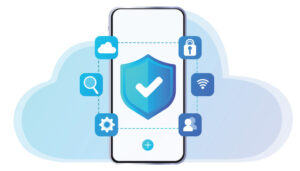Securing applications today is one of the top priorities for businesses. As cybercrime increases, businesses need to stay updated with security solutions for the highest protection.
Investing in robust security solutions will keep hackers away from penetrating applications. However, it doesn’t matter how good a defense mechanism is. The focus is to fix the threat impacts at every application layer inside the network.
To begin with, outline the steps to secure business applications.
How Application Security Works

Application security involves improved security practices in the software development process. As the security keeps improving, the software works better.
Security updates reduce the threat of attacks on systems, applications, or data. It prevents attackers from accessing, deleting, or modifying sensitive data. Security of applications aims to protect integrity, confidentiality, and availability of information. Developers define the security requirements per the brands’ focus during software development.
Software developers commonly use firewalls for software security purposes. Firewalls help to keep files and data safe under stringent passcode systems. It also determines how businesses use files and handle data on a particular program installation. Firewalls also protect the IP address from leaking.
Here are other firewall protection types available:
- Spyware detection and deletion programs
- Conventional firewalls
- Antivirus programs
- Encryption and decryption programs
- Biometric authentication systems
Significance of Application Security
Application security is essential for several reasons, such as:
- Application security parameters find and fix vulnerabilities to reduce risks and attacks.
- Software vulnerabilities are common. Not all of them are serious threats. The security parameters track and reduce the chances of becoming a significant threat.
- Proactive Security approaches better serve than reactive security measures. These measures are defensive and reduce attack impacts.
- Application attacks increase when companies move more data and codes into the cloud. So, security measures reduce the impact of attacks on data and codes.
Overlooking key security measures for applications can harm organizations with high intended threats. When assessing application security measures, security leaders must look at the types of weaknesses or threats.
Finding these will help the teams to take a strategic approach to find solutions to mitigate.
List of Common Application Security Threats
Various organizations see The Open Web Application Security Project (OWASP) and Common Weakness Enumeration (CWE) to track existing application weaknesses.
However, the OWASP list focuses on web application software. The CWE list focuses on specific security issues. The goals are to guide developers on securing codes at scale.
Here are the common security threats that companies need to look for:
1. Input Validation Attacks
These attacks occur due to a lack of proper data validation. Attackers use it to run malicious codes in applications.
2. Operating System (OS) Command Attack
The attacks occur when the deactivation of harmful codes is neglected in an OS command. This harms the OS of the software and impacts applications running on it.
3. SQL Injection
The attacks happen on SQL commands. The flaws allow database attacks when the software doesn’t deactivate harmful elements.
4. Cross-Site Flaws
This application security flaw occurs when web applications fail to confirm a user’s request sent purposely. This state can expose data, allowing attackers to insert malicious codes.
5. Malware Attacks
Malware attacks get uploaded in applications and damage files. Attackers can deliver malicious codes faster when software permits such files to upload.
6. Broken Access Attacks
Broken access control attacks allow attackers to bypass access controls. This way, they tend to gain unauthorized access to data or systems.
Based on these attack types, security teams must assess application security patches deeply. They can approach it with the four easy steps.
Step 1: Define Security Requirements
Security teams and developers must establish precise security requirements to ensure secure applications. It means defining the types of data application use and handling and the degree of security it requires. Here are a few points to proceed with security requirements.
-
Identify Types of Data for Applications
Identify the data types among personal, financial, or confidential business data categories. These data types have specific security requirements. That’s why defining it will be easier for security teams to add protection layers.
-
Determine the Sensitivity of Data Types
This step indicates the need to determine the sensitivity of data types. It will help businesses to add appropriate security layers of protection.
-
Identify Potential Security Threats
Security teams and developers must identify potential app security threats to define application security requirements. This will include internal and external threats, such as data breaches, cyber-attacks, and unauthorized access.
Step 2: Designing of Security Controlling System
Designing a security-controlling system is crucial to protect applications from threats. Security teams must know the threats and their possible impact. They have to set security controls accordingly. Here are some additional steps to follow:
-
Determine appropriate security controls
The security controls businesses choose will depend on the security required. It also depends on the data types applications use.
For financial applications, the Security will need robust security controls. Likewise, data will decide the level of control necessary. Issue Industry-based Standard security practices
Businesses must use industry-standard security practices for applications to run. Their guidelines will ensure that applications are authentic and secure. They need user authentication and authorization, encryption, data backup, and secure coding activities. Tool a secure development lifecycle (SDLC)
This security practice ensures that security patches are available throughout the software development process. SDLC includes the design, implementation, requirements, testing, and maintenance of security solutions. It helps to integrate security solutions into every stage of the process.
Step 3: Install Security Controls
The step is all about implementing controls effectively. The security controls are integrated into application codes, infrastructure, and processes. The controls are tested to ensure they work properly.
Also Read: A Closer Look at Emerging Application Security Drifts in 2023
Step 4: Monitoring and Maintenance
Application security measures need to be consistent. Security teams should continue monitoring and applying maintenance activities.
Regular security audits are also necessary to track all security parameters. The audits identify potential risks and vulnerabilities and tighten up loose patches.
Security management is a crucial task while assessing application security. Applications are prone to vulnerabilities. As a result, vendors integrate updated security patches that reduce impacts.
An incident response plan is also essential to mitigate the impact of threats. The plan should include steps to identify, understand, and resolve security incidents.
For more such updates follow us on Google News ITsecuritywire News. Please subscribe to our Newsletter for more updates.









